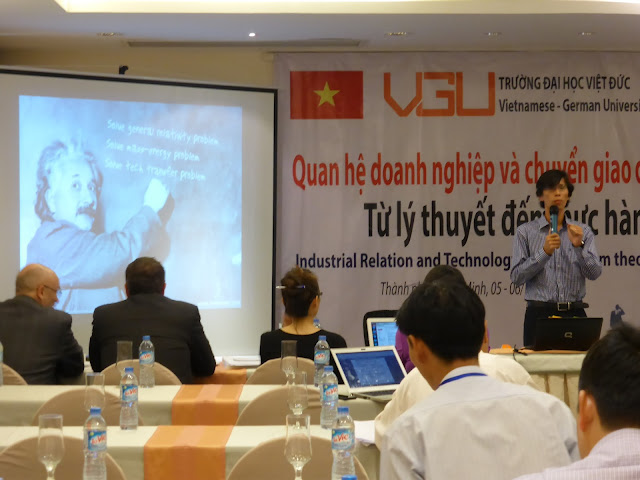The GAST Travelling Conference is part of the activities initiated by
the German - ASEAN Science & Technology (GAST) Network and supported
by the German Federal Ministry of Education and Research. This year
2015, the 6th Conference was held in Jakarta (9.11), Bangkok (11.11) and
Ho Chi Minh City (Binh Duong, 13.11). It brought together leading
experts from Germany and Southeast Asia to share insights and
experiences on the overall theme “Modern Metro Systems for Environmental Friendly Megacities”.
On 13th of November 2015, the GAST Travelling Conference was
organized by the Vietnamese-German University on its VGU Binh Duong
Campus, Binh Duong Province, Vietnam. There were total 12 presentations:
1. Planning and Operation of Rail-bound Public Transport Systems in Growing Asian Metropolitan Areas, by Prof. Dr.-Ing. Hans-Joachim Hollborn, Institute for Traffic, University of Technology Darmstadt.
Notes: We need integrated transport planning., which is a combination between different systems that makes it easier for passengers. We have to develop different possibilities of appropriate pricing and charging devices and financing instruments, paying attention to affordability.
Construction of a railbound transport system needs an investment of:
at level: 20 Mio Euro per km
elevated: 40-50 Mio Euro per km (x2-2.5)
underground: 80-110 Mio Euro per km (x4-5.5).
2. Integrated strategies to increase urban railway ridership in developing countries, by Dr. Vu Anh Tuan, Vietnam German Traffic Research Center, Vietnam German University.
Notes: Urban transport issues in Asia:
- Rapid economic growths --> rapid urbanization/suburbanization.
- Mixed land uses and high-density development patterns.
- Over concentration in capital cities.
- Rapid increase in transport demand but inadequate supply of road infrastructure.
- Lack of public transport infrastructure and services --> rapid increase in private vehicles (especially motorcycles) ---> problems of congestion, pollution, and accidents.
At low income, motorcycle ownership has dominant share; at higher income, motorcycle coexisting with car ownership.
Causes of low ridership including:
- Improper network planning and unwell integrated network development.
- Lack of integration with land use planning and development (along the rail corridors).
- Poor accessibility to railway stations (lack of feeder services and Park & Ride facilities).
- Lack of integration with other modes.
- Lack of integrated, flexible, affordable ticket system.
- The dominance of private vehicles, especially motorcycles (mobile, accessible, flexible and convenient).
5-i measures to integrate Metro with the environment:
- Landuse integration: high density and mixed land use development around the stations (TOD - Transit-oriented development), pedestrian-oriented design in the station area.
- Network integration: bus and railway integrated, feeder services and intermodal facilities.
- Information integration: easy-to-use passenger guide/signage/ITS.
- Fare integration: single fare card and transfer discount.
- Institutional integration: common institutional framework to coordinate land use planning, travel demand management and integrated public transport services.
Travel behaviour survey results showed that people are not willing to walk over 200-300 m long. However, if the walking condition improved (more interesting, not disturbed by traffics, better walking environment), people may be willing to walk up to 800-1000 m.
Downtown should not have park and ride system, but integrated bus system and metro. Park and ride should only recommend in suburban.
Conclusions:
- Metro system needs to be well-integrated with other essential components of the urban environment to attract more motorcycle and car users.
- Small investments to improve metro station accessibility and integration with other modes will increase riderships (and revenue) significantly.
- Making metro system a team player, integration and coordination are a key and must be carefully considered right from the planning step.
3. Urban Transport Concepts for fast growing Cities, by
Dipl.-Ing. Hartmut Märgner, GOPA / PT Metro Transportama Consultant / SIC Infraconsultant.
Jakarta: no sun because of pollution. Time spent in car 2-3 hours (when it rains can be up to 4 hours). We should have long-term vision and start early at the planning stage otherwise it will cost a lots later.
What do we have to do to attract people to use public transportation?
- Customer expectation: safety, comfort to use, easily accessible, punctuality, parking availability.
Concept of interoperability:
- distance between stations, 1000-1500 m.
- less different systems lead to higher capacity and more comfort for customers.
4. Transport Alliances and customer convenience in German traffic systems, by Nils Laschinsky, Association of German Transport Companies
5. Thailand’s Urban Transportation Development in a Provincial Level, by Dr. Siradol Siridhara, Transport Planning Specialist, member of Thai Railway Engineering Association.
6. Metro development in Vietnam with effective use of energy, by Dr. Luu Xuan Hung, Vice Director, Railway Management Board Hanoi.

7. Materials and Approaches for lightweight construction of metro systems, by Prof. Dr.-Ing. Heinrich Kern, Institute of Materials Science and Engineering, Technische Universität Ilmenau.
8. Catchment area analysis for future metro system in Ho Chi Minh City: findings and propositions, by Dr. Pham Thai Son, Vietnam German University.
9. Improvement
effectiveness of the use of MRT by redeveloping MRT station area using
land readjustment tool - development challenges for Ho Chi Minh City, by Dr. Nguyen Ngoc Hieu, Vietnam German University.
10. Efficient Maintenance of Turnkey Metro Systems - 16 years of experience in Bangkok, by Armin Rosocha, Siemens Limited.
11. Further Education and Research in Railway Operations at RWTH Aachen University, by Dipl.-Ing. Marcel Schneider, Institute of Transport Sciences, RWTH Aachen University.
12. Moving towards rail transportation engineering program, by Assoc. Prof. Phumin Kirawanich, Mahidol University.
























































